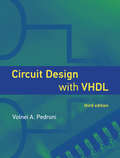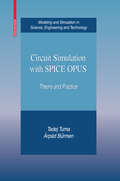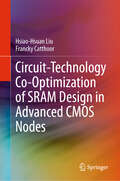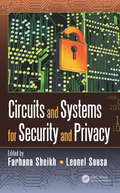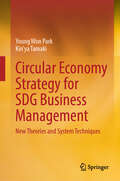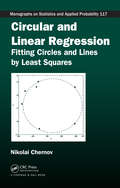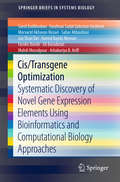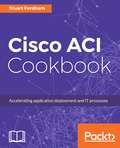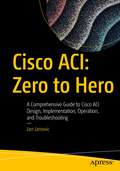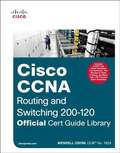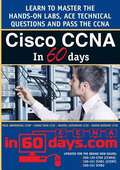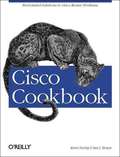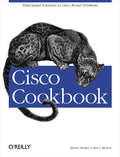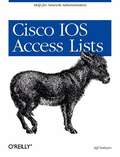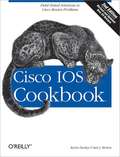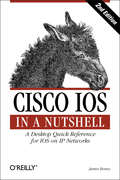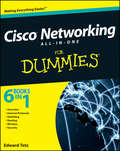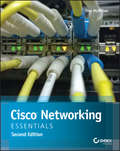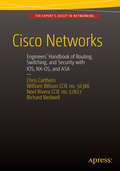- Table View
- List View
Circuit Design with VHDL, third edition (The\mit Press Ser.)
by Volnei A. PedroniA completely updated and expanded comprehensive treatment of VHDL and its applications to the design and simulation of real, industry-standard circuits.This comprehensive treatment of VHDL and its applications to the design and simulation of real, industry-standard circuits has been completely updated and expanded for the third edition. New features include all VHDL-2008 constructs, an extensive review of digital circuits, RTL analysis, and an unequaled collection of VHDL examples and exercises. The book focuses on the use of VHDL rather than solely on the language, with an emphasis on design examples and laboratory exercises.The third edition begins with a detailed review of digital circuits (combinatorial, sequential, state machines, and FPGAs), thus providing a self-contained single reference for the teaching of digital circuit design with VHDL. In its coverage of VHDL-2008, it makes a clear distinction between VHDL for synthesis and VHDL for simulation. The text offers complete VHDL codes in examples as well as simulation results and comments. The significantly expanded examples and exercises include many not previously published, with multiple physical demonstrations meant to inspire and motivate students. The book is suitable for undergraduate and graduate students in VHDL and digital circuit design, and can be used as a professional reference for VHDL practitioners. It can also serve as a text for digital VLSI in-house or academic courses.
Circuit Simulation Methods and Algorithms (Electronic Engineering Systems #4)
by Jan OgrodzkiCircuit Simulation Methods and Algorithms provides a step-by-step theoretical consideration of methods, techniques, and algorithms in an easy-to-understand format. Many illustrations explain more difficult problems and present instructive circuits. The book works on three levels:The simulator-user level for practitioners and students who want to better understand circuit simulators. The basic theoretical level, with examples, dedicated to students and beginning researchers. The thorough level for deep insight into circuit simulation based on computer experiments using PSPICE and OPTIMA. Only basic mathematical knowledge, such as matrix algebra, derivatives, and integrals, is presumed.
Circuit Simulation with SPICE OPUS: Theory and Practice (Modeling and Simulation in Science, Engineering and Technology)
by Tadej Tuma Árpád BuermenThis book is a unique combination of a basic guide to general analog circuit simulation and a SPICE OPUS software manual, which may be used as a textbook or self-study reference. The book is divided into three parts: mathematical theory of circuit analysis, a crash course on SPICE OPUS, and a complete SPICE OPUS reference guide. All simulations as well as the free simulator software may be directly downloaded from the SPICE OPUS homepage: www.spiceopus.si. Circuit Simulation with SPICE OPUS is intended for a wide audience of undergraduate and graduate students, researchers, and practitioners in electrical and systems engineering, circuit design, and simulation development.
Circuit-Technology Co-Optimization of SRAM Design in Advanced CMOS Nodes
by Francky Catthoor Hsiao-Hsuan LiuModern computing engines—CPUs, GPUs, and NPUs—require extensive SRAM for cache designs, driven by the increasing demand for higher density, performance, and energy efficiency. This book delves into two primary areas within ultra-scaled technology nodes: (1) advancing SRAM bitcell scaling and (2) exploring innovative subarray designs to enhance power-performance-area (PPA) metrics across technology nodes. The first part of the book utilizes a bottom-up design-technology co-optimization (DTCO) approach, employing a dedicated PPA simulation framework to evaluate and identify the most promising strategies for SRAM bitcell scaling. It offers a comprehensive examination of SRAM bitcell scaling beyond 1 nm node, outlining a structured research cycle that includes identifying scaling bottlenecks, developing cutting-edge architectures with complementary field-effect transistor (CFET) technology, and addressing challenges such as process integration and routing complexities. Additionally, this book introduces a novel write margin methodology to better address the risks of write failures in resistance-dominated nodes. This methodology accounts for time-dependent parasitic bitline effects and incorporates timing setup of write-assist techniques to prevent underestimating the yield loss. In the second part, the focus shifts to a top-down DTCO approach due to the diminishing returns of bitcell scaling beyond 5 Å node at the macro level. As technology scales, increasing resistance and capacitance (RC) lead designers to adopt smaller subarray sizes to reduce effective RC and enhance subarray-level PPA. However, this approach can result in increased inter-subarray interconnect overhead, potentially offsetting macro-level improvements. This book examines the effects of various subarray sizes on macro-level PPA and finds that larger subarrays can significantly reduce interconnect overhead and improve the energy-delay-area product (EDAP) of SRAM macro. The introduction of the active interconnect (AIC) concept enables the use of larger subarray sizes, while integrating carbon nanotube FET as back-end-of-line compatible devices results in macro-level EDAP improvements of up to 65% when transitioning from standard subarrays to AIC divided subarrays. These findings highlight the future trajectory of SRAM subarray design in deeply scaled nodes.
Circuits and Systems for Security and Privacy (Devices, Circuits, and Systems)
by Farhana Sheikh Leonel SousaCircuits and Systems for Security and Privacy begins by introducing the basic theoretical concepts and arithmetic used in algorithms for security and cryptography, and by reviewing the fundamental building blocks of cryptographic systems. It then analyzes the advantages and disadvantages of real-world implementations that not only optimize power, area, and throughput but also resist side-channel attacks. Merging the perspectives of experts from industry and academia, the book provides valuable insight and necessary background for the design of security-aware circuits and systems as well as efficient accelerators used in security applications.
Circular Business Models in the Manufacturing Industry: Insights from Small Open Economies (Studies in Energy, Resource and Environmental Economics)
by Jurgita Bruneckienė Lina Dagilienė Viktorija Varaniūtė Justina BanionienėThe book takes a multi-level perspective, focusing on circular business models by manufacturing industries in European small open economies. The book conceptualises circular business models and combines theoretical foundations with best practices when such models appeared in the textile, furniture, and plastics industries. It also explores barriers, drivers, challenges, and opportunities for leading manufacturing companies to implement circular activities across the value chain. This book offers a qualitative and transformative approach, spread across three different manufacturing industries, towards a circular transition. The findings will be of interest to practitioners and managers, policymakers, and general readers who are interested in the circular economy and environmental sustainability.
Circular Economy Strategy for SDG Business Management: New Theories and System Techniques
by Young Won Park Kin'ya TamakiThis book delineates the framework to research and develop new theories and system techniques for a circular economy (CE) strategy to fulfill Sustainable Development Goals (SDGs) in the era of digital, sustainable, and green transformation (DX, SX, and GX). For that purpose, five system techniques are presented here: (1) multi-generational and circular economy value chain management (CE-VCM), (2) cyclical resource supply and resource collection, (3) CE product planning and digital marketing, (4) lifecycle design of IoT (Internet of Things) products, and (5) a sharing platform and application software compatible with CE-VCM. The book also explores how to proceed with international trends in research concerning CE policies and standards in Japan, the EU, and the USA. Included are case studies of advanced CE companies in diverse industries, such as automobiles, electronics, food and agriculture, and software, to name just a few. Surveys of trends in CE policy and successful industry case studies in Japan are presented and compared with those in other countries. In the past, the Japanese manufacturing industry was primarily based on the business model of selling off the products introduced into the market and the 3R tactics of &“reuse, reduce, and recycle&” to follow up on waste disposal. Compared to global movements, however, the responses to the CE trend in Japan, the Japanese government's CE policy, and CE management strategy in the Japanese industrial world have lagged considerably behind. In the future, when Japanese companies conduct global business transactions, it will be pivotal for them to implement a CE management strategy compatible with the ISO 59000 series. The Japanese government and global companies must respond to the SDGs, including Goal 12: Producer and Consumer Responsibility. To keep up with external environmental trends, Japanese global firms also must respond to the changes discussed in this informative volume.
Circular Economy and Environmental Resilience: Solutions for a Sustainable Tomorrow, Volume 1
by Pardeep Singh Vandana Mishra Shikha Daga Kiran YadavThis book comprehensively covers the contemporary topic of circular economy and its role in promoting environmental resilience and sustainability. It provides extensive coverage by focusing on the existing environmental issues and how circular practices can help mitigate climate change and bring a development that is not only inclusive but also green. It would be thus immensely useful for the industrialists, academicians, researchers and policymakers working in the area of circular practices, sustainability and environmental protection and resilience. The book addresses the issue of environmental resilience and the role that circular economic practices can play in promoting a development that is not only inclusive and green but also sustainable. The book is an immense use to academicians, students, researchers, policymakers and international organisations working in the area of sustainability and circular economy practices.
Circular and Linear Regression: Fitting Circles and Lines by Least Squares (Chapman & Hall/CRC Monographs on Statistics and Applied Probability)
by Nikolai ChernovFind the right algorithm for your image processing applicationExploring the recent achievements that have occurred since the mid-1990s, Circular and Linear Regression: Fitting Circles and Lines by Least Squares explains how to use modern algorithms to fit geometric contours (circles and circular arcs) to observed data in image processing and comput
Cis/Transgene Optimization: Systematic Discovery Of Novel Gene Expression Elements Using Bioinformatics And Computational Biology Approaches (Springerbriefs In Systems Biology Ser.)
by Saeid Kadkhodaei Farahnaz Sadat Golestan Hashemi Morvarid Akhavan Rezaei Sahar Abbasiliasi Joo Shun Tan Hamid Rajabi Memari Faruku Bande Ali Baradaran Mahdi Moradpour Arbakariya B. AriffThis book is a practical review which focuses on computational analysis and on in silico approaches towards the systematic discovery of various key functional gene expression elements in microalgae as a model. So far, in this regard very little information is available. Efficient stepwise procedures for analysing the matrix attachment regions (MARs) are outlined, as well as for translation initiation sites (TIS), signal peptide (SP) sequences, gene optimization and transformation systems. These outlines can be efficiently deployed as practical models for the systematic discovery of key expression elements and for the optimization of cis/transgenes in other micro/organisms. The first chapter is an introduction on the key gene expression elements analysed in this book, including scaffold/matrix attachment regions, translation initiation sites, signal peptides as well as gene optimization. Chapter 2 focuses on systematic strategies and computational approaches toward in silico analysis of each factor. The analyses outcomes is assessed individually in chapter 3 followed by developing the specific conceptual models for each element in Chapter 4. The concluding remarks are discussed in Chapter 5. This work is of interest to computational and experimental biologists interested in transcriptional regulation analysis as well as to researchers and scientists who wish to consider the use of bioinformatics and computational biology in design, analysis, or regulatory reviews of key gene expression elements for the production of recombinant proteins experiments.
Cisco ACI Cookbook
by Stuart FordhamOver 90 recipes to maximize automated solutions and policy-drive application profiles using Cisco ACI About This Book • Confidently provision your virtual and physical infrastructure for application deployment • Integrate Cisco ACI with hypervisors and other third party devices • Packed with powerful recipes to automate your IT operations Who This Book Is For If you are a network administrator, system administrator, or engineer and are aware of the basics of Cisco ACI but want to start using it to automate your tasks, then this book is for you What You Will Learn • Master the Cisco ACI architecture • Discover the ACI fabric with easy-to-follow steps • Set up quality of service within ACI • Configure external networks with Cisco ACI • Integrate with VMware and track VMware virtual machines • Configure apply and verify access policies • Extend or migrate a VMware virtual-machine LAN inside the ACI fabric • Monitor ACI with third party tools and troubleshoot issues In Detail Cisco Application Centric Infrastructure (ACI) is a tough architecture that automates IT tasks and accelerates data-center application deployments. This book focuses on practical recipes to help you quickly build, manage, and customize hybrid environment for your organization using Cisco ACI. You will begin by understanding the Cisco ACI architecture and its major components. You will then configure Cisco ACI policies and tenants. Next you will connect to hypervisors and other third-party devices. Moving on, you will configure routing to external networks and within ACI tenants and also learn to secure ACI through RBAC. Furthermore, you will understand how to set up quality of service and network programming with REST, XML, Python and so on. Finally you will learn to monitor and troubleshoot ACI in the event of any issues that arise. By the end of the book, you will gain have mastered automating your IT tasks and accelerating the deployment of your applications. Style and approach A set of exciting recipes to automate your IT operations related to datacenters, the Cloud, and networking tasks
Cisco ACI: A Comprehensive Guide to Cisco ACI Design, Implementation, Operation, and Troubleshooting
by Jan JanovicIt doesn’t matter if you are completely new to Cisco ACI or you already have some experience with the technology, this book will guide you through the whole implementation lifecycle and provide you with a comprehensive toolset to become confident in any ACI-related task. In the beginning, it’s very important to build strong fundamental knowledge about Cisco ACI components. We'll go through underlay networking based on Nexus 9000 switches and describe the APIC controller cluster acting as the management plane of ACI. By building Access Policies, you'll see how to optimally connect servers, storage, routers, switches, or L4-L7 service devices to ACI. Then we'll properly design and implement Logical Application Policies. You will understand all the fabric forwarding behavior when using different ACI settings and architectures while getting a toolset on how to verify and troubleshoot eventual problems. This book also covers external L2 and L3 connectivity in ACI, more advanced features like integration with virtualization hypervisors and Kubernetes, service chaining of L4-L7 devices using Service Graphs, or practical approach to using REST API automation based on Python and Ansible/Terraform.Cisco ACI: Zero to Hero can additionally be used as a valuable source of theoretical and practical knowledge for all candidates preparing for CCIE DC v3.0 Written or Lab exams.What You'll LearnUnderstand network evolution and Cisco ACI components Underlay ACI networking based on Nexus 9000 switches, APIC controllers, and Application Policy ModelIntegrate ACI with virtualization hypervisors and KubernetesDynamically and seamlessly include L4-L7 service devices in communication between ACI endpoints Build ACI Anywhere: ACI Multi-Tier, Stretched Fabric, Multi-POD, Multi-Site, and Remote LeafUtilize ACI REST API with Python, related Cobra SDK, Ansible or Terraform, to develop automation and scripts on top of the ACI platformWho This Book Is ForNetwork engineers, architects, network developers, administrators or NOC technicians.
Cisco CCNA Routing and Switching 200-120: Official Cert Guide Library
by Wendell OdomCisco Press is the official publisher for the New CCENT & CCNA Routing and Switching Certifications. The New Edition of the Best-Selling two-book value priced CCNA Official Cert Guide Library includes Updated Content, New Exercises, 8 Practice Exams, and 150 Minutes of Video Training -- PLUS the CCENT and CCNA Network Simulator Lite Editions with 26 Free Network Simulator Labs. CCNA 200-120 Official Cert Guide Library is a comprehensive review and package for the latest CCNA exams. The two books contained in this package, CCENT / CCNA ICND1 100-101 Official Cert Guide and CCNA ICND2 200-101 Official Cert Guide, present complete reviews and a more challenging and realistic preparation experience. The books have been fully updated to refresh the content for the latest CCNA exam topics and enhance certain key topics that are critical for exam success. Best-selling author and expert instructor Wendell Odom shares preparation hints and test-taking tips, helping you identify areas of weakness and improve both your conceptual knowledge and hands-on skills. This complete study package includes A test-preparation routine proven to help you pass the exams Do I Know This Already? quizzes, which enable you to decide how much time you need to spend on each section Chapter-ending and part-ending exercises, which help you drill on key concepts you must know thoroughly Troubleshooting sections, which help you master the complex scenarios you will face on the exam The powerful Pearson IT Certification Practice Test software, complete with hundreds of well-reviewed, exam-realistic questions, customization options, and detailed performance reports A free copy of the CCNA ICND1 and ICND2 Network Simulator Lite software, complete with meaningful lab exercises that help you hone your hands-on skills with the command-line interface for routers and switches More than 150 minutes of personal video mentoring from the author Final preparation chapters, which guide you through tools and resources to help you craft your review and test-taking strategies Study plan suggestions and templates to help you organize and optimize your study time These official study guides help you master all the topics on the CCNA exams, including: Networking fundamentals Ethernet LANs and switches IPv4 addressing and subnetting Operating Cisco routers Configuring OSPF ACLs and NAT IPv6 fundamentals, implementation, and troubleshooting LAN switching IPv4 routing VPNs OSPF and EIGRP configuration and troubleshooting Wide area networks and Frame Relay Network management Well regarded for its level of detail, study plans, assessment features, challenging review questions and exercises, video instruction, and hands-on labs, these official study guides help you master the concepts and techniques that ensure your exam success. CCNA 200-120 Official Cert Guide Library is part of a recommended learning path from Cisco that includes simulation and hands-on training from authorized Cisco Learning Partners and self-study products from Cisco Press. Companion DVDs The DVDs contain two ICND1 practice exams, two ICND2 practice exams, four full CCNA practice exams, CCENT and CCNA Network Simulator Lite software, and 150 minutes of video training.
Cisco CCNA in 60 Days: Study Guide
by Farai Tafa Dario Barinic Paul Browning Daniel GheorgheThe Cisco CCNA is one of the most widely recognised and respected qualifications in the IT industry. Every year, tens of thousands of people embark towards taking the exam via private study, Cisco Academy courses, or online training. The sad truth is most students quit along the way, and for those few who actually do attempt it, only 50% pass. All that time, effort, and money wasted If there are so many manuals, CBT courses, lab simulators, exam engines, and study resources out there, then what goes wrong? This is the question Cisco trainer Paul Browning wanted to get to the bottom of. After interviewing thousands of students, he discovered that most people quit because they are simply overwhelmed with the sheer volume of material they need to digest and, of course, the large number of hands-on skills they need to be able to demonstrate in the exam. Add to that the day-to-day stresses of commuting to work, bringing up a family, and the distraction of everyday problems and challenges; it's no wonder people quit. This is where Cisco CCNA in 60 Days can help. Devised by two industry experts and countless Cisco students just like you, the 60-day programme breaks down every exam requirement into a daily study task. All you need to do is open the book at the relevant day (from 1 to 60), read the theory, and complete the lab. Every lesson is reviewed several times in the form of exam questions, review sessions, a handy exam cram guide, and, of course, hands-on labs for you to follow. You can choose to take the CCENT after the first 30 days and the ICND2 after the next 30 days, or you can take the CCNA after 60 days of study.
Cisco Certified CyberOps Associate 200-201 Certification Guide: Learn blue teaming strategies and incident response techniques to mitigate cybersecurity incidents
by Glen D. SinghBegin a successful career in cybersecurity operations by achieving Cisco Certified CyberOps Associate 200-201 certificationKey FeaturesReceive expert guidance on how to kickstart your career in the cybersecurity industryGain hands-on experience while studying for the Cisco Certified CyberOps Associate certification examWork through practical labs and exercises mapped directly to the exam objectivesBook DescriptionAchieving the Cisco Certified CyberOps Associate 200-201 certification helps you to kickstart your career in cybersecurity operations. This book offers up-to-date coverage of 200-201 exam resources to fully equip you to pass on your first attempt. The book covers the essentials of network security concepts and shows you how to perform security threat monitoring. You'll begin by gaining an in-depth understanding of cryptography and exploring the methodology for performing both host and network-based intrusion analysis. Next, you'll learn about the importance of implementing security management and incident response strategies in an enterprise organization. As you advance, you'll see why implementing defenses is necessary by taking an in-depth approach, and then perform security monitoring and packet analysis on a network. You'll also discover the need for computer forensics and get to grips with the components used to identify network intrusions. Finally, the book will not only help you to learn the theory but also enable you to gain much-needed practical experience for the cybersecurity industry. By the end of this Cisco cybersecurity book, you'll have covered everything you need to pass the Cisco Certified CyberOps Associate 200-201 certification exam, and have a handy, on-the-job desktop reference guide.What you will learnIncorporate security into your architecture to prevent attacksDiscover how to implement and prepare secure designsIdentify access control models for digital assetsIdentify point of entry, determine scope, contain threats, and remediateFind out how to perform malware analysis and interpretationImplement security technologies to detect and analyze threatsWho this book is forThis book is for students who want to pursue a career in cybersecurity operations, threat detection and analysis, and incident response. IT professionals, network security engineers, security operations center (SOC) engineers, and cybersecurity analysts looking for a career boost and those looking to get certified in Cisco cybersecurity technologies and break into the cybersecurity industry will also benefit from this book. No prior knowledge of IT networking and cybersecurity industries is needed.
Cisco Cookbook
by Kevin Dooley Ian J. BrownEverybody who has worked with Cisco routers for any length of time has had to ask their friends and co-workers for example router configuration files that show how to solve a common problem. A good working configuration example can often save huge amounts of time and frustration when implementing a feature that you've never used before. The Cisco Cookbook gathers hundreds of example router configurations all in one place.
Cisco Cookbook: Field-tested Solutions To Cisco Router Problems (Cookbooks (o'reilly) Ser.)
by Kevin Dooley Ian BrownWhile several publishers (including O'Reilly) supply excellent documentation of router features, the trick is knowing when, why, and how to use these features There are often many different ways to solve any given networking problem using Cisco devices, and some solutions are clearly more effective than others. The pressing question for a network engineer is which of the many potential solutions is the most appropriate for a particular situation. Once you have decided to use a particular feature, how should you implement it? Unfortunately, the documentation describing a particular command or feature frequently does very little to answer either of these questions.Everybody who has worked with Cisco routers for any length of time has had to ask their friends and co-workers for example router configuration files that show how to solve a common problem. A good working configuration example can often save huge amounts of time and frustration when implementing a feature that you've never used before. The Cisco Cookbook gathers hundreds of example router configurations all in one place.As the name suggests, Cisco Cookbook is organized as a series of recipes. Each recipe begins with a problem statement that describes a common situation that you might face. After each problem statement is a brief solution that shows a sample router configuration or script that you can use to resolve this particular problem. A discussion section then describes the solution, how it works, and when you should or should not use it. The chapters are organized by the feature or protocol discussed. If you are looking for information on a particular feature such as NAT, NTP or SNMP, you can turn to that chapter and find a variety of related recipes. Most chapters list basic problems first, and any unusual or complicated situations last.The Cisco Cookbook will quickly become your "go to" resource for researching and solving complex router configuration issues, saving you time and making your network more efficient. It covers:Router Configuration and File ManagementRouter ManagementUser Access and Privilege LevelsTACACS+IP RoutingRIPEIGRPOSPFBGPFrame RelayQueueing and CongestionTunnels and VPNsDial BackupNTP and TimeDLSwRouter Interfaces and MediaSimple Network Management ProtocolLoggingAccess ListsDHCPNATHot Standby Router ProtocolIP Multicast
Cisco IOS Access Lists
by Jeff SedayaoThis book focuses on a critical aspect of the Cisco IOS--access lists, which are central to securing routers and networks. Administrators cannot implement access control or traffic routing policies without them. The book covers intranets, firewalls, and the Internet. Unlike other Cisco router titles, it focuses on practical instructions for setting router access policies rather than the details of interfaces and routing protocol settings.
Cisco IOS Cookbook
by Kevin Dooley Ian J. BrownNever has something cried out for a cookbook quite as much as Cisco's Internetwork Operating System (IOS). IOS is powerful and flexible, but also confusing and daunting. Most tasks can be accomplished in several different ways. And you don't want to spend precious time figuring out which way is best when you're trying to solve a problem quickly. That's what this cookbook is for. Fortunately, most router configuration tasks can be broken down into several more or less independent steps: you configure an interface, you configure a routing protocol, you set up backup links, you implement packet filters and other access control mechanisms. What you really need is a set of recipes that show you how to perform the most common tasks, so you can quickly come up with a good configuration for your site. And you need to know that these solutions work: you don't want to find yourself implementing a backup link at 2 A.M. because your main link is down and the backup link you set up when you installed the router wasn't quite right. Thoroughly revised and expanded, Cisco IOS Cookbook, 2nd Edition, adds sections on MPLS, Security, IPv6, and IP Mobility, and presents solutions to the most common configuration problems, including: * Configuring interfaces of many types, from serial to ATM and Frame Relay * Configuring all of the common IP routing protocols (RIP, EIGRP, OSPF, and BGP) * Configuring authentication * Configuring other services, including DHCP and NTP * Setting up backup links, and using HSRP to configure backup routers * Managing the router, including SNMP and other solutions * Using access lists to control the traffic through the router If you work with Cisco routers, you need a book like this to help you solve problems quickly and effectively. Even if you're experienced, the solutions and extensive explanations will give you new ideas and insights into router configuration. And if you're not experienced- if you've just been given responsibility for managing a network with Cisco routers- this book could be a job-saver.
Cisco IOS Cookbook: Field-Tested Solutions to Cisco Router Problems
by Kevin Dooley Ian BrownNever has something cried out for a cookbook quite as much as Cisco's Internetwork Operating System (IOS). IOS is powerful and flexible, but also confusing and daunting. Most tasks can be accomplished in several different ways. And you don't want to spend precious time figuring out which way is best when you're trying to solve a problem quickly.That's what this cookbook is for. Fortunately, most router configuration tasks can be broken down into several more or less independent steps: you configure an interface, you configure a routing protocol, you set up backup links, you implement packet filters and other access control mechanisms. What you really need is a set of recipes that show you how to perform the most common tasks, so you can quickly come up with a good configuration for your site. And you need to know that these solutions work: you don't want to find yourself implementing a backup link at 2 A.M. because your main link is down and the backup link you set up when you installed the router wasn't quite right.Thoroughly revised and expanded, Cisco IOS Cookbook, 2nd Edition, adds sections on MPLS, Security, IPv6, and IP Mobility, and presents solutions to the most common configuration problems, including:Configuring interfaces of many types, from serial to ATM and Frame RelayConfiguring all of the common IP routing protocols (RIP, EIGRP, OSPF, and BGP)Configuring authenticationConfiguring other services, including DHCP and NTPSetting up backup links, and using HSRP to configure backup routersManaging the router, including SNMP and other solutionsUsing access lists to control the traffic through the routerIf you work with Cisco routers, you need a book like this to help you solve problems quickly and effectively. Even if you're experienced, the solutions and extensive explanations will give you new ideas and insights into router configuration. And if you're not experienced--if you've just been given responsibility for managing a network with Cisco routers--this book could be a job-saver.
Cisco IOS in a Nutshell: A Desktop Quick Reference for IOS on IP Networks
by James BoneyCisco routers are everywhere that networks are. They come in all sizes, from inexpensive units for homes and small offices to equipment costing well over $100,000 and capable of routing at gigabit speeds. A fixture in today's networks, Cisco claims roughly 70% of the router market, producing high-end switches, hubs, and other network hardware. One unifying thread runs through the product line: virtually all of Cisco's products run the Internetwork Operating System, or IOS.If you work with Cisco routers, it's likely that you deal with Cisco's IOS software--an extremely powerful and complex operating system, with an equally complex configuration language. With a cryptic command-line interface and thousands of commands--some of which mean different things in different situations--it doesn't have a reputation for being user-friendly.Fortunately, there's help. This second edition of Cisco IOS in a Nutshell consolidates the most important commands and features of IOS into a single, well-organized volume that you'll find refreshingly user-friendly.This handy, two-part reference covers IOS configuration for the TCP/IP protocol family. The first section includes chapters on the user interface, configuring lines and interfaces, access lists, routing protocols, and dial-on-demand routing and security. A brief, example-filled tutorial shows you how to accomplish common tasks.The second part is a classic O'Reilly quick reference to all the commands for working with TCP/IP and the lower-level protocols on which it relies. Brief descriptions and lists of options help you zero in on the commands you for the task at hand. Updated to cover Cisco IOS Software Major Release 12.3, this second edition includes lots of examples of the most common configuration steps for the routers themselves. It's a timely guide that any network administrator will come to rely on.
Cisco Networking All-in-One For Dummies
by Edward TetzA helpful guide on all things CiscoDo you wish that the complex topics of routers, switches, and networking could be presented in a simple, understandable presentation? With Cisco Networking All-in-One For Dummies, they are! This expansive reference is packed with all the information you need to learn to use Cisco routers and switches to develop and manage secure Cisco networks. This straightforward-by-fun guide offers expansive coverage of Cisco and breaks down intricate subjects such as networking, virtualization, and database technologies into easily digestible pieces. Drills down complex subjects concerning Cisco networking into easy-to-understand, straightforward coverageShares best practices for utilizing Cisco switches and routers to implement, secure, and optimize Cisco networksReviews Cisco networking solutions and products, securing Cisco networks, and optimizing Cisco networksDetails how to design and implement Cisco networksWhether you're new to Cisco networking products and services or an experienced professional looking to refresh your knowledge about Cisco, this For Dummies guide provides you with the coverage, solutions, and best practices you need.
Cisco Networking Essentials
by Troy McmillanAn engaging approach for anyone beginning a career in networking As the world leader of networking products and services, Cisco products are constantly growing in demand. Yet, few books are aimed at those who are beginning a career in IT--until now. Cisco Networking Essentials provides a solid foundation on the Cisco networking products and services with thorough coverage of fundamental networking concepts. Author Troy McMillan applies his years of classroom instruction to effectively present high-level topics in easy-to-understand terms for beginners. With this indispensable full-color resource, you'll quickly learn the concepts, processes, and skills that are essential to administer Cisco routers and switches. Begins with a clear breakdown of what you can expect to learn in each chapter, followed by a straightforward discussion of concepts on core topics Includes suggested labs and review questions at the conclusion of each chapter, which encourage you to reinforce and measure your understanding of the topics discussed Serves as an ideal starting point for learning Cisco networking products and services If you are interested in a career in IT but have little or no knowledge of networking and are new to Cisco networking products, then this book is for you.
Cisco Networks: Engineers' Handbook of Routing, Switching, and Security with IOS, NX-OS, and ASA
by William Wilson Noel Rivera Chris Carthern Richard BedwellThis book is a one-stop desk reference and synopsis of basic knowledge and skills for Cisco certification preparation. For beginning and experienced network engineers tasked with building LAN, WAN, and data center connections, this book lays out clear directions for installing, configuring, and troubleshooting networks with Cisco devices. The full range of certification topics is covered, including all aspects of IOS, NX-OS, and ASA software. The emphasis throughout is on solving the real-world challenges engineers face in configuring network devices, rather than on exhaustive descriptions of hardware features. This practical desk companion doubles as a comprehensive overview of the basic knowledge and skills needed by CCENT, CCNA, and CCNP exam takers. It distills a comprehensive library of cheat sheets, lab configurations, and advanced commands that the authors assembled as senior network engineers for the benefit of junior engineers they train, mentor on the job, and prepare for Cisco certification exams. Prior familiarity with Cisco routing and switching is desirable but not necessary, as Chris Carthern, Dr. Will Wilson, Noel Rivera, and Richard Bedwell start their book with a review of the basics of configuring routers and switches. All the more advanced chapters have labs and exercises to reinforce the concepts learned. This book differentiates itself from other Cisco books on the market by approaching network security from a hacker's perspective. Not only does it provide network security recommendations but it teaches you how to use black-hat tools such as oclHashcat, Loki, Burp Suite, Scapy, Metasploit, and Kali to actually test the security concepts learned. What you'll learn Readers of Cisco Networks will learn How to configure Cisco switches, routers, and data center devices in typical corporate network architectures The skills and knowledge needed to pass Cisco CCENT, CCNA, and CCNP certification exams How to set up and configure at-home labs using virtual machines and lab exercises in the book to practice advanced Cisco commands How to implement networks of Cisco devices supporting WAN, LAN, and data center configurations How to implement secure network configurations and configure the Cisco ASA firewall How to use black-hat tools and network penetration techniques to test the security of your network Who this book is for Cisco Networks is for network designers, engineers, programmers, managers, and students seeking a one-stop book that concisely covers the full gamut of topics configuring, managing and troubleshooting Cisco networks and equipment--whether as a synopsis to prepare for a job or certification exam or as a desk reference to consult on the job. Table of Contents Introduction to Practical Networking The Physical Medium Data Link Layer The Network Layer with IP Intermediate LAN Switching and More L2 Helper Protocols Routing Protocols and Their Practical Implementation VLANs and MSTP Basic Switch and Router Troubleshooting NAT/DHCP Management Plane Data Plane Control Plane Introduction to Availability Advanced Switching Advanced Routing Advanced Security Advanced Troubleshooting Effective Network Management via Network Metadata and Correlation Data Center Wireless LAN ASA and IDS Network Penetration Testing MPLS
Cisco Networks: Engineers' Handbook of Routing, Switching, and Security with IOS, NX-OS, and ASA
by William Wilson Noel Rivera Chris CarthernFor beginning and experienced network engineers tasked with building LAN, WAN, and data center connections, this book lays out clear directions for installing, configuring, and troubleshooting networks with Cisco devices. Cisco Networks, 2nd Edition is a practical guide and desk reference for Cisco engineers. This new edition will discuss tools that can be used to automate and troubleshoot networks. A new chapter on quality of service has been added to teach managing network resources by prioritizing specific types of network traffic. The new edition has an updated wireless section which focuses on an updated controller and integration with Cisco Identity Services Engine (ISE) and Cisco Prime Infrastructure.This practical desk companion doubles as a comprehensive overview of the basic knowledge and skills needed by CCNA and CCNP exam takers. Prior familiarity with Cisco routing and switching is desirable but not necessary, as Chris Carthern, Dr. Will Wilson, and Noel Rivera start their book with a review of network basics. Further they explain practical considerations and troubleshooting when establishing a physical medium for network communications. Later they explain the concept of network layers, intermediate LAN switching, and routing. Next they introduce you to the tools and automation used with Cisco networks. Moving forward they explain management planes, data planes, and control planes. Next they describe advanced security, trouble shooting, and network management. They conclude the book with a section which focuses on using network automation to automate Cisco IOS networks.What You Will LearnConfigure Cisco switches, routers, and data center devices in typical corporate network architecturesUse black-hat tools to conduct penetration testing on the security of your networkConfigure and secure virtual private networks (VPNs)Enable identity management in your network with the Cisco Identity Services Engine (ISE) Who This Book Is For Network designers, engineers, programmers, managers, and students.
